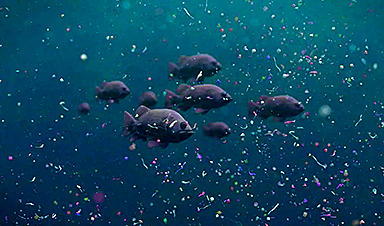New research suggests that microplastics in our oceans might be hundreds of thousands of times more abundant than current detection methods are reporting.
Microplastic particles (MPs) are tiny fragments of plastic, less than 5mm. They result from both commercial production and the breakdown of larger plastics. One of the biggest sources is synthetic fabrics.
Chemicals within microplastics have now made their way into oceans and waterways, and even drinking water, causing concern to scientists and public health officials. The increase of microplastics in aquatic systems is dangerous to both marine life and creatures, including humans, through the consumption of seafood.
Recent reports have also that microplastics themselves are common in every part of the human body, including the testicles.
A new study, published in the Marine Pollution Bulletin, shows that the problem is likely to be even greater than we previously thought.
Using Raman microspectroscopy to determine the chemical makeup of samples, the scientists analysed ocean waters from the Caribbean to the Arctic. Their results show that the most abundant and tiny microplastics aren’t being detected by current methods.
Normally, microplastics in ocean waters are measured using net tow surveys. Tightly meshed “plankton nets” sieve microplastics out of the water, which can then be analysed.
These plankton nets detect particles between 300–500 micrometres in size, where a micrometre is one millionth of a metre. The Raman microspectroscopy technique is able to reveal microplastics much smaller than just 15 micrometres.
“Our results highlight the numerical primacy of small microplastic particles in seawater, and we found that the most abundant microplastics were between 1 and 14 micrometres,” says first author Medina Faull, from Stony Brook University in New York. “60% were under 5 micrometres, and none were larger than 53 micrometres.”
“This size fraction has been totally overlooked in almost all marine microplastics.” Faull adds.
The Raman microspectroscopy based research found microplastics less than 53 micrometres in size hundreds of thousands of times more often than all the combined reports around the globe using traditional detection techniques.

The false-color images of green and red match for specific polymers detected in the particle. Credit: Luis Medina Faull.
“Understanding health risks from exposure to microplastics is a vastly understudied area, and investigations are needed to understand the health impacts from microplastics of different shapes, sizes, and compositions,” says Jaymie Meliker, a public health researcher at Stony Brook University who was not involved in the study.
Faull emphasises the need for wider research on microplastics in the ocean.
“Firstly, most of the ocean is grossly under-sampled, and the majority of existing data is based on towed net studies. And smaller, less buoyant microplastic particles residing below the ocean’s upper few meters are almost never sampled. Secondly, understanding sources of microplastics transport and final landing locations such as ocean floors is crucial to explain the distribution patterns of microplastics throughout the ocean,” he explains.
News
Two New Books From Frank Boehm, NA Founder – To be Released Dec. 2025
Molecular Manufacturing: The Future of Nanomedicine This book explores the revolutionary potential of atomically precise manufacturing technologies to transform global healthcare, as well as practically every other sector across society. This forward-thinking volume examines [...]
What could the future of nanoscience look like?
Society has a lot to thank for nanoscience. From improved health monitoring to reducing the size of electronics, scientists’ ability to delve deeper and better understand chemistry at the nanoscale has opened up numerous [...]
Scientists Melt Cancer’s Hidden “Power Hubs” and Stop Tumor Growth
Researchers discovered that in a rare kidney cancer, RNA builds droplet-like hubs that act as growth control centers inside tumor cells. By engineering a molecular switch to dissolve these hubs, they were able to halt cancer [...]
Platelet-inspired nanoparticles could improve treatment of inflammatory diseases
Scientists have developed platelet-inspired nanoparticles that deliver anti-inflammatory drugs directly to brain-computer interface implants, doubling their effectiveness. Scientists have found a way to improve the performance of brain-computer interface (BCI) electrodes by delivering anti-inflammatory drugs directly [...]
After 150 years, a new chapter in cancer therapy is finally beginning
For decades, researchers have been looking for ways to destroy cancer cells in a targeted manner without further weakening the body. But for many patients whose immune system is severely impaired by chemotherapy or radiation, [...]
Older chemical libraries show promise for fighting resistant strains of COVID-19 virus
SARS‑CoV‑2, the virus that causes COVID-19, continues to mutate, with some newer strains becoming less responsive to current antiviral treatments like Paxlovid. Now, University of California San Diego scientists and an international team of [...]
Lower doses of immunotherapy for skin cancer give better results, study suggests
According to a new study, lower doses of approved immunotherapy for malignant melanoma can give better results against tumors, while reducing side effects. This is reported by researchers at Karolinska Institutet in the Journal of the National [...]
Researchers highlight five pathways through which microplastics can harm the brain
Microplastics could be fueling neurodegenerative diseases like Alzheimer's and Parkinson's, with a new study highlighting five ways microplastics can trigger inflammation and damage in the brain. More than 57 million people live with dementia, [...]
Tiny Metal Nanodots Obliterate Cancer Cells While Largely Sparing Healthy Tissue
Scientists have developed tiny metal-oxide particles that push cancer cells past their stress limits while sparing healthy tissue. An international team led by RMIT University has developed tiny particles called nanodots, crafted from a metallic compound, [...]
Gold Nanoclusters Could Supercharge Quantum Computers
Researchers found that gold “super atoms” can behave like the atoms in top-tier quantum systems—only far easier to scale. These tiny clusters can be customized at the molecular level, offering a powerful, tunable foundation [...]
A single shot of HPV vaccine may be enough to fight cervical cancer, study finds
WASHINGTON -- A single HPV vaccination appears just as effective as two doses at preventing the viral infection that causes cervical cancer, researchers reported Wednesday. HPV, or human papillomavirus, is very common and spread [...]
New technique overcomes technological barrier in 3D brain imaging
Scientists at the Swiss Light Source SLS have succeeded in mapping a piece of brain tissue in 3D at unprecedented resolution using X-rays, non-destructively. The breakthrough overcomes a long-standing technological barrier that had limited [...]
Scientists Uncover Hidden Blood Pattern in Long COVID
Researchers found persistent microclot and NET structures in Long COVID blood that may explain long-lasting symptoms. Researchers examining Long COVID have identified a structural connection between circulating microclots and neutrophil extracellular traps (NETs). The [...]
This Cellular Trick Helps Cancer Spread, but Could Also Stop It
Groups of normal cbiells can sense far into their surroundings, helping explain cancer cell migration. Understanding this ability could lead to new ways to limit tumor spread. The tale of the princess and the [...]
New mRNA therapy targets drug-resistant pneumonia
Bacteria that multiply on surfaces are a major headache in health care when they gain a foothold on, for example, implants or in catheters. Researchers at Chalmers University of Technology in Sweden have found [...]
Current Heart Health Guidelines Are Failing To Catch a Deadly Genetic Killer
New research reveals that standard screening misses most people with a common inherited cholesterol disorder. A Mayo Clinic study reports that current genetic screening guidelines overlook most people who have familial hypercholesterolemia, an inherited disorder that [...]





















